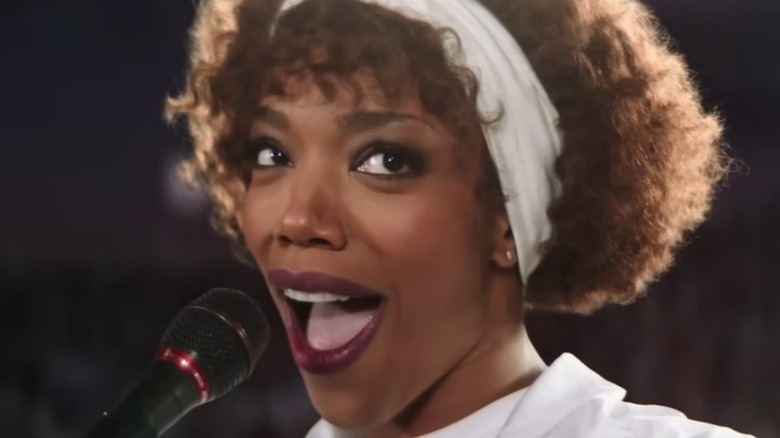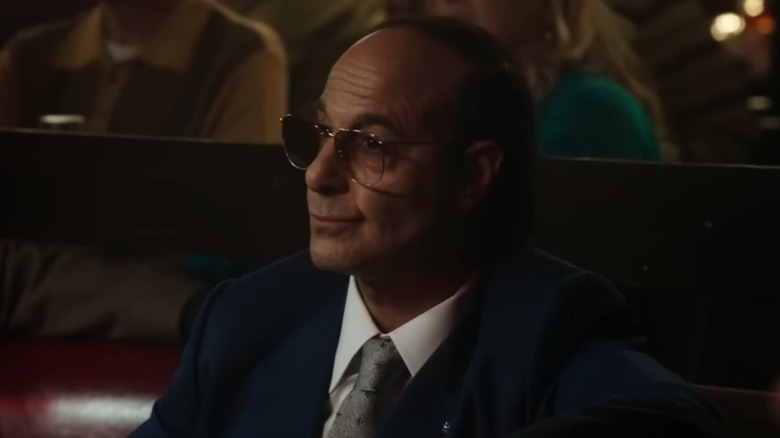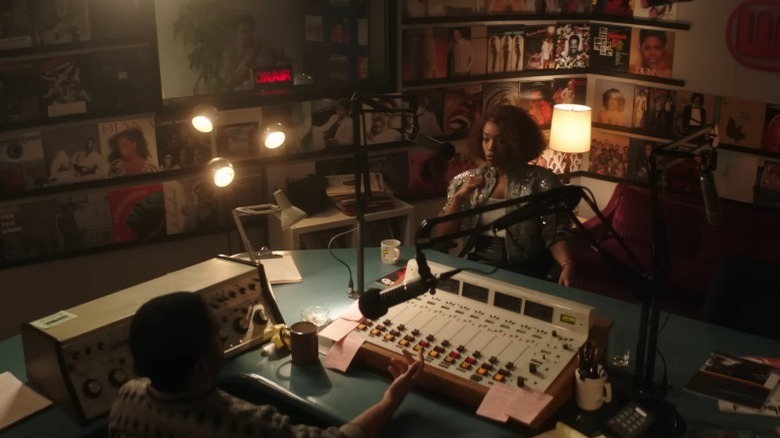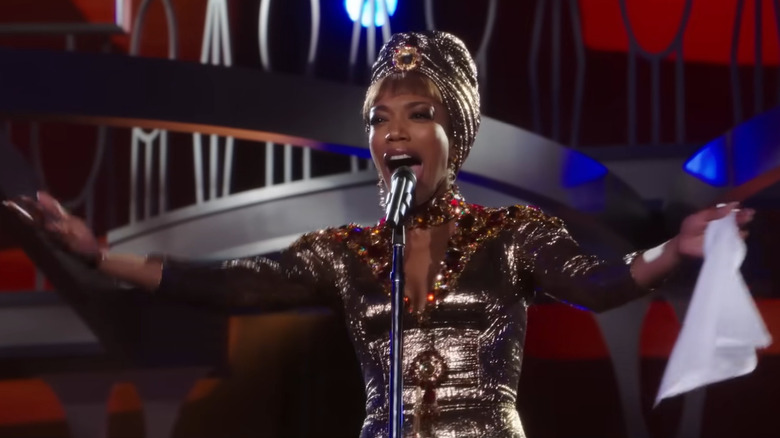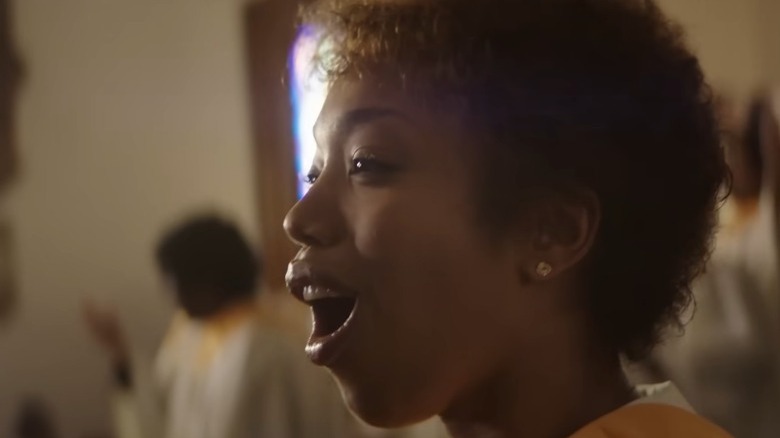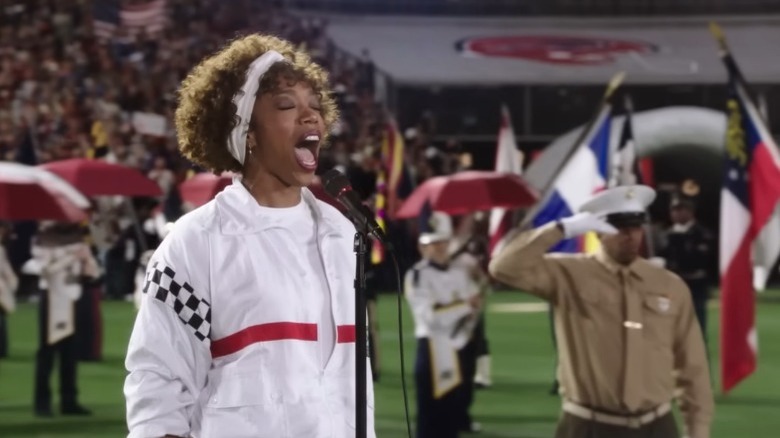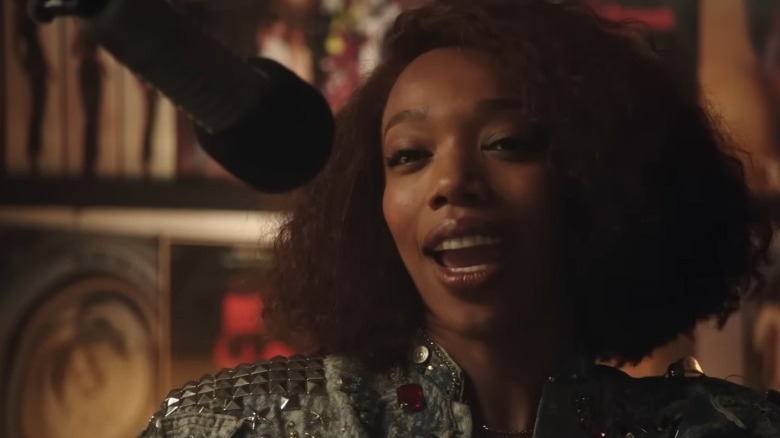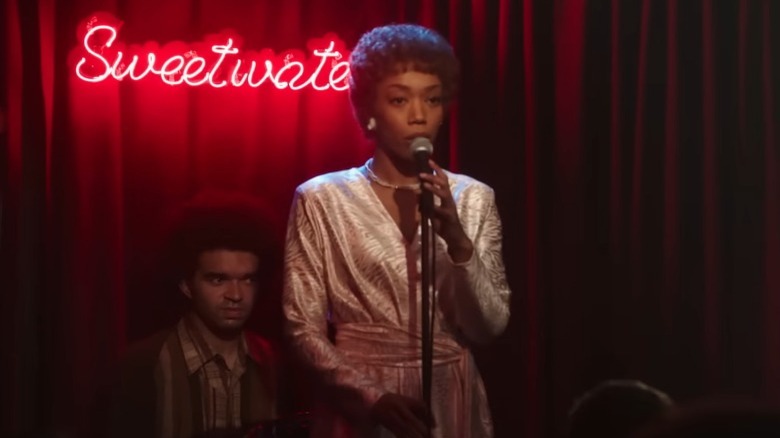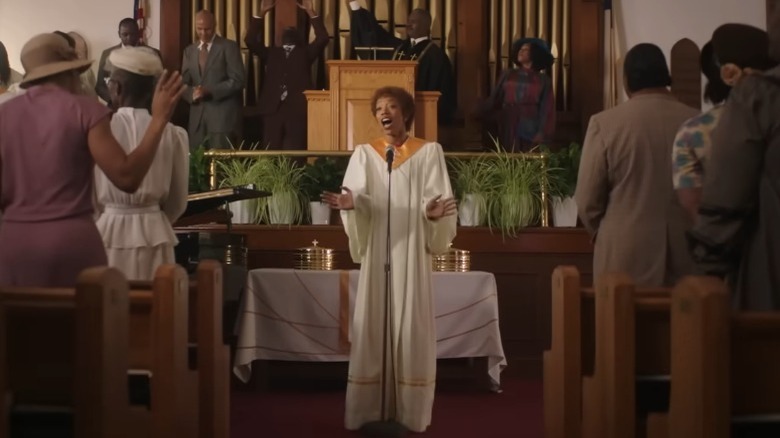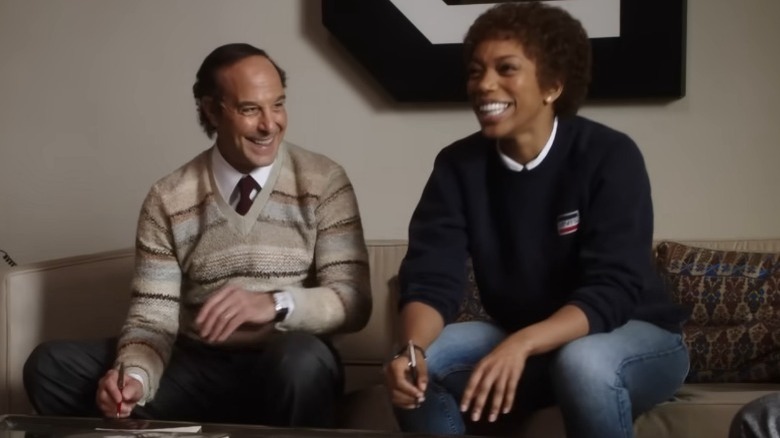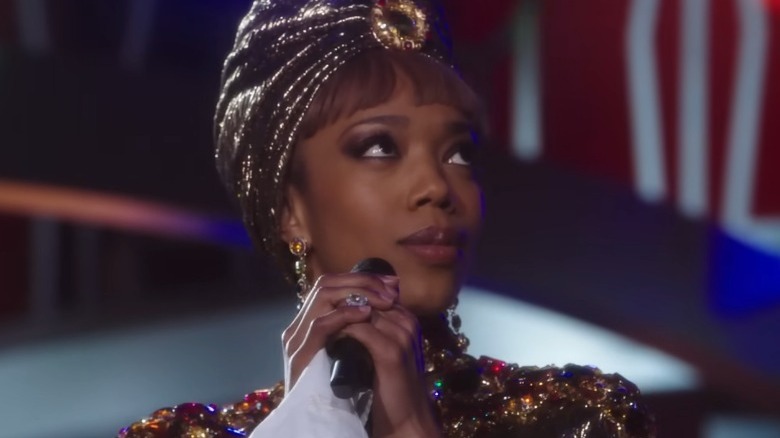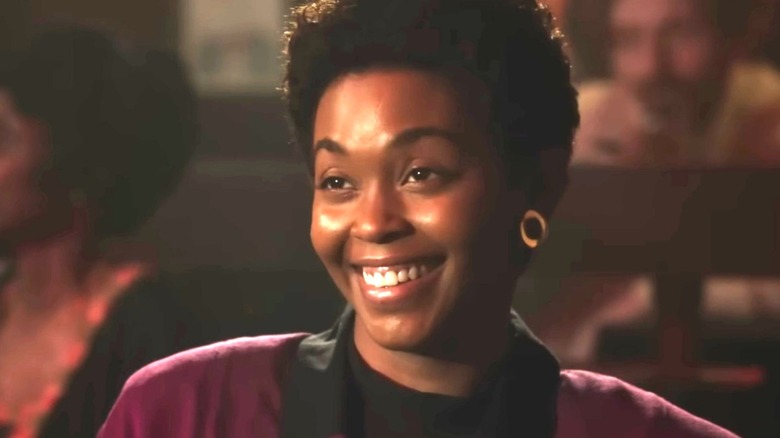Everything I Wanna Dance With Somebody Gets Wrong About The True Story
Whitney Houston is, without a doubt, one of the greatest singers who's ever lived. Her incredible voice touched the lives of millions and made an impact on popular music that will never be forgotten. There have been plenty of memoirs, biographies, films, and shows created about Houston and her remarkable career, but the latest movie might be the most accurate.
Directed by Kasi Lemmons, "I Wanna Dance with Somebody" endeavors to tell Houston's story without shying away from its most tragic elements. Because of that, the ending of the film might leave audiences feeling a little deflated, but with its powerhouse cast and steady supply of big musical numbers, there's more than enough to fall in love with.
Though Houston's life story is undeniably compelling, "I Wanna Dance with Somebody" makes many of the same mistakes that other musical biopics have taken up before. The movie packs a ton of detail into its 2 hour and 24 minute runtime, but it still manages to breeze through some of the most important parts of Houston's life, and it flattens some of the characters who played big roles in her story. For everything it succeeds in doing, there's still plenty that "I Wanna Dance with Somebody" gets wrong about the true story.
How she got discovered
Sometimes when "I Wanna Dance with Somebody" tells a true story, it embellishes what actually happened just slightly. In the film, Whitney Houston ends up being discovered when she performs in place of her mother at an event. The movie shows Houston's mother feigning a bout of laryngitis in order to convince her daughter to perform, and that single white lie transforms the lives of Houston and her family forever.
In real life, things didn't come together quite so perfectly. Houston really did perform alongside her mother, but the picture-perfect white lie didn't happen. According to Clive Davis (via the official Whitney Houston YouTube channel), he first saw Houston perform as a backup singer in a club called Sweetwater. At one point she got to sing two solo pieces, and her performance of "The Greatest Love of All" blew Davis away. "It was sung with such fervor, with such natural vocal gifts, with such passion that I was stunned," Davis said. "I knew really right then and there that this was a very special talent." Based on that performance, Davis decided to sign Houston, and the two of them went on to have a professional relationship that lasted the rest of her life and changed the course of music history.
The radio interview
Whenever someone steps into the public eye, they're bound to face plenty of criticism from unexpected places, and Whitney Houston is no exception. Her meteoric rise to pop music fame riled up some would-be fans and turned them against her. Al Sharpton famously dubbed her "Whitey Houston" and joined a chorus of voices complaining that Houston was marketing herself to white audiences at the expense of the Black community (via The Guardian). Though Houston arguably proved her critics wrong over and over again, many of them never let up, and this critique haunted some of the biggest moments of Houston's career, like her appearance at the Soul Train Awards in 1989.
Houston responded to the criticism more than once throughout her career, but never quite in the way that "I Wanna Dance with Somebody" depicts. In the film, Houston shows up to a radio station for an interview and gets asked point blank how she feels about what Sharpton and others have been saying about her. Rather than one specific radio interview Houston's response in the film is a paraphrased version of what she said in several other interviews over the decades, with outlets like Ebony and Today.
The Soul Train Awards
In showing one of the most dramatic moments of Whitney Houston's career, "I Wanna Dance with Somebody" gets a couple of its wires crossed. In the film, Houston attends the 1988 Soul Train Awards hoping to walk away with some major recognition. Unfortunately, she not only loses out on the Best Music Video award to Janet Jackson, she also gets a chorus of boos from the audience, many of whom accuse Houston of selling out to white audiences. The scene is heartbreaking, but it's also not exactly accurate.
In real life, Houston did lose out to Jackson in 1988, but she didn't actually attend the award ceremony that year. Despite not being there, the crowd did still give Houston a negative reaction (clips still exist on YouTube), and that energy didn't go away after 1988. The next year Houston did make her way to the ceremony, and her experience there was much closer to what the movie depicted. In 1989 Houston lost in the R&B Soul Single category to Anita Baker, got booed by a portion of the audience, and met her future husband Bobby Brown (per Essence).
The Soul Train Awards might not have been all that welcoming to Houston in the late 80s, but in 2000 she was named Female Artist of the Decade, so she eventually got the recognition that she deserved.
Kevin Costner's influence
Whitney Houston isn't just known for her musical talent. In the '90s she also got involved in making movies, and 1992's "The Bodyguard" put her career on a whole new track. The film took advantage of Houston's singing abilities and included a cover of Dolly Parton's "I Will Always Love You" that ended up being almost more memorable than the movie itself. In "I Wanna Dance with Somebody," it's Houston's longtime career partner Clive Davis who sells her on doing the song. He brings her a tape with the track on it and says that Houston's costar Kevin Costner had suggested using it in the movie.
Davis might have ultimately been responsible for getting Houston involved in the production of "The Bodyguard," but in real life Costner himself did much of the heavy lifting with the film's musical choices. Houston revealed in an interview (via Restless Rick on YouTube) that Costner pulled her aside to talk about what the movie's big song should be. "Kevin brought it back to me in the trailer one day," Houston said, "and he said, 'I'm telling you this is the song.'" Though at first she was hesitant because Parton's version was a country song, Houston gave it another listen and realized she couldn't stop singing it to herself the whole next day. It ended up being the perfect choice for the movie.
Tracksuit weather
There are plenty of iconic moments from Whitney Houston's career, but few stand out quite as much as her performance of "The Star-Spangled Banner" at the 1991 Super Bowl. It wasn't just Houston's incredible voice or the rendition's unique arrangement that made the performance so memorable. It was also the blazing white tracksuit that Houston chose to wear for the occasion.
In the lead-up to the performance that's shown in "I Wanna Dance with Somebody," Houston's clothing choice comes across as a statement of identity. She's given multiple dresses to choose from, but she turns them all down because she wants to look more like herself while she's performing.
There might be some truth to that version of events, but people who knew Houston tell the story a little differently. In her memoir "A Song for You: My Life with Whitney Houston," Robyn Crawford explained that the weather was much colder than anyone had anticipated, and though she wanted something warmer than a dress, Houston was reluctant to go with her now iconic tracksuit (via Glamour). According to Crawford, she eventually convinced Houston that it was the right decision. Rickey Minor, Houston's longtime music director, told Today that she chose the tracksuit, recalling, "After she performed she wanted to be comfortable to go and sit in her box and relax and watch the game." Houston's clothing choice may have been driven by practicality, but it ended up making a bold statement anyway.
Bobby Brown's baby
Fitting a person's life story into a movie that's a little over two hours long is a tall order. "I Wanna Dance with Somebody" manages to tell a story that's remarkably accurate, but from time to time the demands of having a reasonable runtime force the movie to compress events that didn't necessarily happen together. In the film, Bobby Brown proposes to Houston in the back of a limo, and in the very same scene he confesses that his ex is pregnant with his baby. Houston, understandably, gets out of the limo immediately, and it takes a while for her and Brown to reconcile after his confession.
If the whole ordeal seems like an extreme case of bad timing on Brown's part, his real-life counterpart would likely agree. Brown laid out his proposal to Houston in his memoir "Every Little Step," and in that version of events, the subject of his baby never came up. Houston's best friend Robyn Crawford claims that Brown made his confession over the phone at a later date, and the BET miniseries "Bobby Brown Story" has him revealing the truth to Houston backstage after a performance. While the specifics might be in question, "I Wanna Dance with Somebody" does manage to get the emotional beats of the Brown/Houston relationship mostly correct.
How the marriage ended
Retelling the story of any relationship is always a challenge, and the truth about Whitney Houston and Bobby Brown's relationship is particularly complicated. The two of them spent most of their lives, individually and as a couple, in the public eye, and a regular drip of celebrity gossip followed them wherever they went. The media was obsessed with the ups and downs of their relationship, but despite the flood of details reported about the two of them, "I Wanna Dance with Somebody" keeps its telling of their story rather simple.
In the film, drug use causes massive tension between Houston and Brown, but it's after Houston's initial attempt at getting sober that their relationship finally falls apart. When she leaves rehab, Houston meets up with Brown and gives him back her wedding ring. To a certain extent, the movie gets that part of the story correct. In real life, Houston was the one who filed for divorce and officially ended the relationship (via People). That said, real life isn't necessarily so cut and dry. In his memoir "Every Little Step," Brown claims, "The reality is I walked away," so there's still something of a question mark hanging over the end of their relationship.
Missing her father's funeral
"I Wanna Dance with Somebody" understandably takes a hard look at Whitney Houston's drug abuse. Considering how much of a negative impact drugs had on Houston's life, it makes sense for the film to turn drug abuse into a pseudo-antagonist, but there's at least one moment that the film might have embellished a little too much. After Houston's father dies, she skips out on his funeral, and the film cuts to shots of Houston strung out at home, suggesting she missed the funeral because she was high.
Houston really did skip her father's funeral, but there's actually more to the story than what the movie presents. In 2009 Houston told Oprah Winfrey that she had a fraught relationship with her father in the years leading up to his death, but the two of them managed to settle their differences between themselves shortly before he died. She said that the real reason she didn't attend the funeral was because of all the media attention it received. "I had a memorial the day before the funeral that was my own. That was my own. That was just my family," she said. She didn't want to face the press, so Houston chose to mourn her father privately.
Multiple attempts at recovery
Even though "I Wanna Dance with Somebody" spends a lot of time examining Whitney Houston's relationship to drugs, the movie still manages to gloss over important aspects of the real story. The movie portrays Houston going into a rehab program, but it ends up telling an oversimplified story about her struggle with addiction that leaves out the full extent of her attempts at recovery.
Houston's mother Cissy, among other friends and family, supported her in her ongoing battle. Over the first decade of the 2000s, Houston checked herself into multiple rehab programs (via People). Despite all her efforts, drugs kept working their way back into Houston's life. She told Oprah Winfrey in 2009 that she was drug free, but sometime between that interview and her death in 2012 she began using again.
If you or anyone you know needs help with addiction issues, help is available. Visit the Substance Abuse and Mental Health Services Administration website or contact SAMHSA's National Helpline at 1-800-662-HELP (4357).
Whitney's final hours
"I Wanna Dance with Somebody" doesn't shy away from the fact that drug use led to Whitney Houston's death in February 2012. In fact, the version of events that are depicted in the film show Houston buying drugs and taking them up to her hotel room on the day of her death. Telling the story that way gets right to the heart of the matter, but it avoids the messier reality of how things actually played out that day.
Though there were drugs in Houston's system at the time of her death — which was officially ruled an accidental drowning (via People) — the precise events leading up to her final moments are totally up for speculation. There's no real evidence that Houston bought drugs shortly before her death, but there also isn't anyone who's come forward, for obvious reasons, to say they made the purchase for her. The real truth will likely forever remain a mystery.
Kissing Robyn Crawford
"I Wanna Dance with Somebody" does shed new light on the tragic parts of Whitney Houston's life, but it also highlights one of her strongest and most uplifting personal relationships. Robyn Crawford is Houston's best friend in the beginning of the film, but it isn't long before the two of them begin having romantic feelings toward one another. The movie fully embraces the nuances of Houston's sexuality and shows her and Crawford's first kiss shortly before Houston is whisked away into a life of international fame.
The relationship between Houston and Crawford is entirely based on their real lives, but the specifics of how that relationship unfolds are ever so slightly fictionalized (via The Los Angeles Times). Crawford wrote about her intimate relationship with Houston in her memoir "A Song for You: My Life with Whitney Houston," and that part of Houston's story had a profound impact on "I Wanna Dance with Somebody" director Kasi Lemmons.
It was Lemmons who pushed for the Houston/Crawford relationship to be at the heart of her film, and she worked hard to get their kiss included in the final product, even though it didn't necessarily happen the same way in real life. "I said, 'Well, presumably they kissed. We really can surmise that there was a romance there,'" she told The LA Times. The movie's kiss may have been created by the film's writers, but it demonstrates the truth of Houston's relationship with Crawford.
